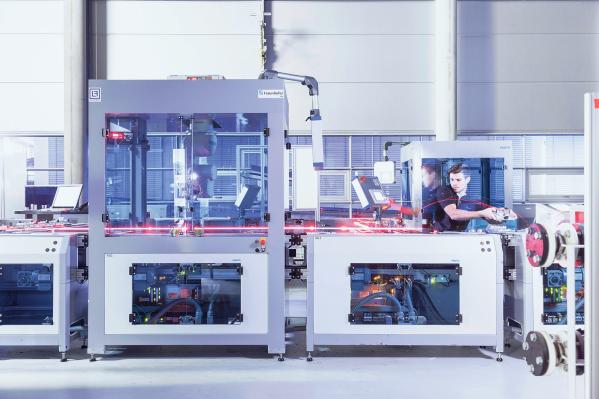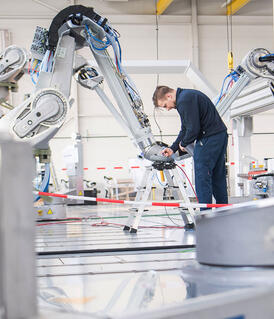SMEs: made in Germany – in demand worldwide

The Mittelstand is the beating heart of the German economy. Despite the presence of many global players Global players They are the flagships of the economy and global players with an international footing – the major German corporations. The top brands include Daimler, BMW, SAP, Siemens, Volkswagen and Adidas. Shares in the major German companies are listed in the German share index (DAX) at the Frankfurt stock… Read more › and internationally famous major corporations, Germany’s 3.5 million small and medium-sized enterprises ( SMEs SMEs The German economy is characterized first and foremost by small and medium-sized enterprises as well as the self-employed and the independent professions. Some 99.4 percent of all companies are small and medium-sized enterprises. These are firms with annual sales of below EUR 50 million and a… Read more › ), freelancers and self-employed professionals are the distinctive feature of the country’s economic structure. More than 99 percent of German companies are SMEs.
An SME is a firm
- with an annual turnover of less than 50 million euros and
- fewer than 500 employees.
Nearly one in four self-employed professionals has non-German roots
Many migrants work in SMEs SMEs The German economy is characterized first and foremost by small and medium-sized enterprises as well as the self-employed and the independent professions. Some 99.4 percent of all companies are small and medium-sized enterprises. These are firms with annual sales of below EUR 50 million and a… Read more › , and over 800,000 people from migrant backgrounds own their own business, making migrants in Germany a major factor in the economy.
How international are Germany’s SMEs?
The “German Mittelstand” also plays a major role on the international stage. Worldwide, there are around 4,000 “hidden champions” - more than 1,700 of them are German SMEs SMEs The German economy is characterized first and foremost by small and medium-sized enterprises as well as the self-employed and the independent professions. Some 99.4 percent of all companies are small and medium-sized enterprises. These are firms with annual sales of below EUR 50 million and a… Read more › .
German SMEs are European or global market leaders in their respective fields thanks to their
- highly innovative products and problem solutions,
- strong customer focus and
- short decision-making processes.
German SMEs think globally
Around 763,000 SMEs SMEs The German economy is characterized first and foremost by small and medium-sized enterprises as well as the self-employed and the independent professions. Some 99.4 percent of all companies are small and medium-sized enterprises. These are firms with annual sales of below EUR 50 million and a… Read more › from Germany are active abroad. On average, they generate 29 percent of their total sales outside Germany.
The EU single market is the most important foreign market for the great majority of Germany’s industrial SMEs SMEs The German economy is characterized first and foremost by small and medium-sized enterprises as well as the self-employed and the independent professions. Some 99.4 percent of all companies are small and medium-sized enterprises. These are firms with annual sales of below EUR 50 million and a… Read more › – when it comes both to procuring intermediate and semi-finished products and selling their own products. In terms of importance, the European single market is followed by other non-EU countries and China.
Around 16 percent of German SMEs SMEs The German economy is characterized first and foremost by small and medium-sized enterprises as well as the self-employed and the independent professions. Some 99.4 percent of all companies are small and medium-sized enterprises. These are firms with annual sales of below EUR 50 million and a… Read more › have customers, suppliers, competitors or their own facilities in the United States.
The creative economy is driving change
Comprising SMEs SMEs The German economy is characterized first and foremost by small and medium-sized enterprises as well as the self-employed and the independent professions. Some 99.4 percent of all companies are small and medium-sized enterprises. These are firms with annual sales of below EUR 50 million and a… Read more › for the most part, the creative sector is an integral part of Germany’s economic fabric. It is a pioneer as Germany transitions into a digital and knowledge-based economy, and is a significant source of innovations Innovations In 2021, company spending on research and development rose to 75.8 billion Euros. The automotive industry accounts for a large share of these investements. Read more › . There are roughly 238,000 companies employing around two million people in the cultural and creative sector. The Berlin Berlin Once a year, during the Berlinale film festival, the world of the silver screen focuses its attention on Berlin. And the city’s inhabitants are used to global interest. After all, the people of Berlin have lived in a capital city since 1458. However, there is also a shady side to the city’s history… Read more › - Brandenburg Brandenburg Brandenburg surrounds the capital city of Berlin and benefits from the latter’s “gin and martini belt”. However, with its numerous lakes and forests it also has several trump cards of its own. With the Hohenzollern castles, and in particular Sanssouci Castle, which is included in the UNESCO World… Read more › region is an international hotspot for creative industries and start-ups.


